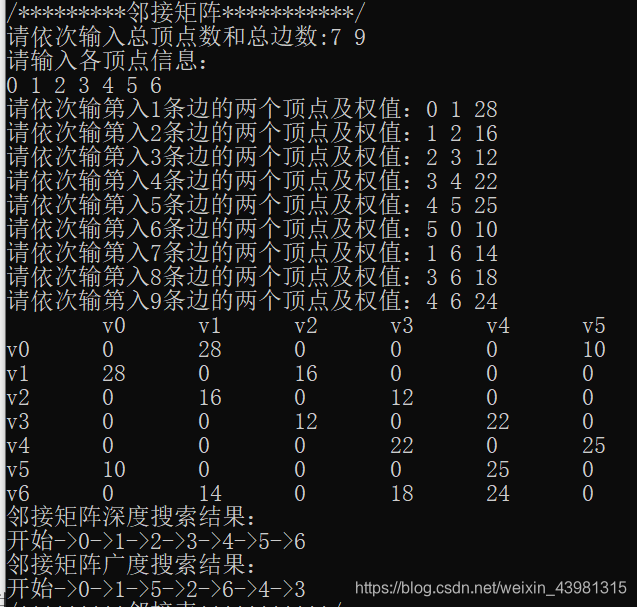题目:
以0结点为起点实现上述图的深度优先和广度优先遍历算法;
思路:
(1) 邻接矩阵深度搜索:从起始点开始循环,对下一层第一个点开始往下搜索,穷尽后,再返回上一层的第n个点搜索。如果该点没被访问过,则输出;
(2) 邻接矩阵广度搜索:建立队列,把起始点放入队列,建立循环,把队首的所有边连接的结点放入队列,如果队首未被访问则输出并弹出,直到队空退出。
(3) 邻接表深度搜索:从起始点开始循环,对下一层第一个点开始往下搜索,穷尽后,再返回上一层的第n个点搜索。如果该点没被访问过,则输出;
(4) 邻接表广度搜索:建立队列,把起始点放入队列,建立循环,把队首的所有边连接的结点放入队列,如果队首未被访问则输出并弹出,直到队空退出。
代码块:
#include "pch.h"
#include <iostream>
#include<queue>
using namespace std;
#define MVNum 100
typedef char VerTexType;//顶点数据类型设置为字符
typedef int ArcType;//边的权值为整型
typedef int OtherInfo;
bool visited[MVNum] = { false };
/*********邻接矩阵***********/
struct AMGraph {
VerTexType vexs[MVNum];//顶点表
ArcType arcs[MVNum][MVNum];//邻接矩阵
int vexnum;//顶点数量
int arcnum;//边数量
};
int Locatevex(AMGraph G, VerTexType v)//定位顶点下标
{
for (int i = 0; i < G.vexnum; i++)//遍历寻找对应顶点下标
{
if (G.vexs[i] == v)
{
return i;
}
}
cout << "顶点输入错误,请重新检查!" << endl;//顶点输入错误处理
return -1;
}
void CreateUDN(AMGraph&G)
{
cout << "请依次输入总顶点数和总边数:";
cin >> G.vexnum >> G.arcnum;
cout << "请输入各顶点信息:" << endl;
for (int i = 0; i < G.vexnum; i++)//请输入各顶点信息
{
cin >> G.vexs[i];
}
for (int i = 0; i < G.vexnum; i++)//将邻接矩阵初始化为0
{
for (int j = 0; j < G.vexnum; j++)
{
G.arcs[i][j] = 0;
}
}
for (int k = 0; k < G.arcnum; k++)
{
VerTexType v1, v2;
int w;
cout << "请依次输第入" << k + 1 << "条边的两个顶点及权值:";
cin >> v1 >> v2 >> w;
int i = Locatevex(G, v1);//找到顶点在图中边的下标
int j = Locatevex(G, v2);
if (i != -1 && j != -1)//如果能找到对应顶点,对边赋权值
{
G.arcs[i][j] = w;
G.arcs[j][i] = w;
}
}
}
void DFS_AM(AMGraph G, int v)//邻接矩阵的深度搜索
{
cout << "->" << v;
visited[v] = true;//访问过的点置true
for (int j = 0; j < G.vexnum; j++)
{//搜索具有以该点为顶点的边的另一个顶点
if (G.arcs[v][j] && visited[j] == false)
{
DFS_AM(G, j);
}
}
return;
}
void BFS_AM(AMGraph G, int v)//邻接矩阵的广度搜索
{
for (int i = 0; i < G.vexnum; i++)
{//将visited数组置false
visited[i] = false;
}
queue<int>q;//建立队列
q.push(v);
visited[v] = true;//当前点放入队列并置true
while (!q.empty())
{//队列非空
cout << "->" << q.front();
v = q.front();//当前顶点置为队首
for (int i = 0; i < G.vexnum; i++)
{//搜索具有以该点为顶点的边的另一个顶点
if (G.arcs[v][i] && visited[i] == false)
{
q.push(i);
visited[i] = true;
}
}
q.pop();
}
}
/*********邻接表***********/
struct ArcNode {
int adjvex;//连接的顶点下标
struct ArcNode *nextarc;//下一节点
OtherInfo info;//权值
};
struct VNode {
VerTexType data;//顶点数据
ArcNode *firstarc;//边的连接点
};
struct ALGraph {
VNode vertices[MVNum];//顶点数组
int vexnum;//顶点总数
int arcnum;//边总数
};
int Locatevex(ALGraph G, VerTexType v)//定位顶点下标
{
for (int i = 0; i < G.vexnum; i++)//遍历寻找对应顶点下标
{
if (G.vertices[i].data == v)
{
return i;
}
}
cout << "顶点输入错误,请重新检查!" << endl;//顶点输入错误处理
return -1;
}
void CreateUDG(ALGraph &G)//创建邻接表
{
cout << "请依次输入总顶点数和总边数:";
cin >> G.vexnum >> G.arcnum;
cout << "请输入各顶点信息:" << endl;
for (int i = 0; i < G.vexnum; i++)//请输入各顶点信息
{
cin >> G.vertices[i].data;
G.vertices[i].firstarc = NULL;
}
for (int k = 0; k < G.arcnum; k++)
{
VerTexType v1, v2;
int w;
cout << "请依次输第入" << k << "条边的两个顶点及权值:";
cin >> v1 >> v2 >> w;
int i = Locatevex(G, v1);//找到顶点在图中边的下标
int j = Locatevex(G, v2);
ArcNode *p1 = new ArcNode;//边用前插法插入到顶点后方
p1->info = w;
p1->adjvex = i;
p1->nextarc = G.vertices[j].firstarc;
G.vertices[j].firstarc = p1;
ArcNode *p2 = new ArcNode;
p2->info = w;
p2->adjvex = j;
p2->nextarc = G.vertices[i].firstarc;
G.vertices[i].firstarc = p2;
}
}
void DFS_AL(ALGraph G, int v) {//邻接表的深度搜索
cout << "->" << v;//输出格式
visited[v] = true;
ArcNode *p = G.vertices[v].firstarc;
while (p)//从一个点开始穷尽搜索,搜索完再重新搜索下一个点
{
int w = p->adjvex;
if (!visited[w]) DFS_AL(G, w);
p = p->nextarc;
}
}
void BFS_AL(ALGraph G, int v)
{//邻接表的广度搜索
for (int i = 0; i < G.vexnum; i++)
{//将visited数组置false
visited[i] = false;
}
queue<int> q;//建立队列
q.push(v);
visited[v] = true;//起始点入队,并设置为已查找
while (!q.empty())
{//队不空则循环
v = q.front();//获取队首
ArcNode *p = G.vertices[v].firstarc;
while (p)//将当前点连接的所有点入队
{
if (visited[p->adjvex]==false)
{
q.push(p->adjvex);
visited[p->adjvex] = true;
}
p = p->nextarc;
}
cout<<"->" << q.front();//弹出队首并输出
q.pop();
}
}
int main()
{
/*********邻接矩阵***********/
cout << "/*********邻接矩阵***********/" << endl;
AMGraph G;
CreateUDN(G);
for (int i = 0; i < G.vexnum; i++)
cout << '\t' << "v" << i;
cout << endl;
for (int i = 0; i < G.vexnum; i++)//输出邻接矩阵
{
cout << "v" << i << '\t';
for (int j = 0; j < G.vexnum; j++)
{
cout << G.arcs[i][j] << '\t';
}
cout << endl;
}
cout << "邻接矩阵深度搜索结果:";
cout << endl << "开始" ;
DFS_AM(G, 0);
cout <<endl<< "邻接矩阵广度搜索结果:";
cout << endl << "开始";
BFS_AM(G, 0);
/*********邻接表***********/
cout <<endl<< "/*********邻接表***********/" << endl;
ALGraph g;
CreateUDG(g);
for (int i = 0; i < g.vexnum; i++)//输出邻接表
{
cout << "第" << i + 1 << "个顶点:" << g.vertices[i].data << endl;
int k = 1;
ArcNode *p = g.vertices[i].firstarc;
while (p)
{
cout << "第" << i + 1 << "个顶点的" << "第" << k << "条边顶点:" << g.vertices[p->adjvex].data << '\t' << "权重:" << p->info << endl;
p = p->nextarc;
k++;
}
}
cout << "邻接表深度搜索结果:";
cout << endl << "开始";
DFS_AL(g, 0);
cout <<endl<< "邻接表广度搜索结果:";
cout << endl << "开始";
BFS_AL(g, 0);
}
效果图:
图一为邻接矩阵的深度和广度搜索,图二三邻接表的深度和广度搜索
























 1万+
1万+











 被折叠的 条评论
为什么被折叠?
被折叠的 条评论
为什么被折叠?








